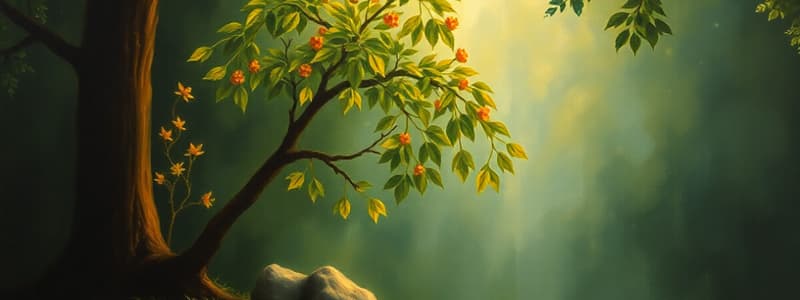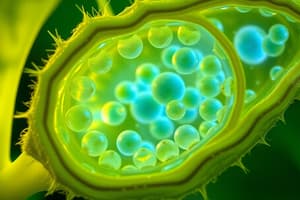Podcast
Questions and Answers
The primary function of the nucleolus is the synthesis of proteins within the plant cell.
The primary function of the nucleolus is the synthesis of proteins within the plant cell.
False (B)
The smooth endoplasmic reticulum (SER) is primarily involved in protein synthesis due to the presence of attached ribosomes.
The smooth endoplasmic reticulum (SER) is primarily involved in protein synthesis due to the presence of attached ribosomes.
False (B)
Plant cells rely on mitochondria for photosynthesis and energy production.
Plant cells rely on mitochondria for photosynthesis and energy production.
False (B)
The plasmodesmata's main function is to provide structural support to the cell.
The plasmodesmata's main function is to provide structural support to the cell.
A cell wall's secondary wall is the initial layer formed during cell growth, providing flexibility.
A cell wall's secondary wall is the initial layer formed during cell growth, providing flexibility.
The matrix within a chloroplast where the light-dependent reactions of photosynthesis occur is called stroma.
The matrix within a chloroplast where the light-dependent reactions of photosynthesis occur is called stroma.
Plant cells maintain turgor pressure with the help of vacuoles.
Plant cells maintain turgor pressure with the help of vacuoles.
The desmotubule within plasmodesmata is directly lined by the cell's wall.
The desmotubule within plasmodesmata is directly lined by the cell's wall.
The presence of centrosomes is a distinguishing characteristic of plant cells, facilitating cell division.
The presence of centrosomes is a distinguishing characteristic of plant cells, facilitating cell division.
The main role of glyoxysomes is photosynthesis.
The main role of glyoxysomes is photosynthesis.
Flashcards
Plant Cell
Plant Cell
Eukaryotic cell that forms many plant tissues.
Nucleus
Nucleus
Controls cell activities and contains genetic material.
Nucleolus
Nucleolus
Region in nucleus; produces ribosomes.
Cytoplasm
Cytoplasm
Signup and view all the flashcards
Golgi Apparatus
Golgi Apparatus
Signup and view all the flashcards
Mitochondria
Mitochondria
Signup and view all the flashcards
Chloroplast
Chloroplast
Signup and view all the flashcards
Cell Wall
Cell Wall
Signup and view all the flashcards
Plasmodesmata
Plasmodesmata
Signup and view all the flashcards
Cell Wall Function
Cell Wall Function
Signup and view all the flashcards
Study Notes
- Plant cells are a type of eukaryotic cell found in many plant tissues
Cell Structure
- Nucleus: Contains genetic material and controls cell activities.
- Nucleolus: The region within the nucleus produces ribosomes.
- Cytoplasm: Gelatinous substance housing cellular organelles.
- Endoplasmic Reticulum (ER): A network of membranes involved in synthesizing and transporting proteins and lipids.
- Rough Endoplasmic Reticulum (RER): Part of the ER with attached ribosomes, involved in protein synthesis.
- Smooth Endoplasmic Reticulum (SER): Part of the ER without ribosomes, involved in lipid synthesis and detoxification.
- Ribosomes: Structures responsible for protein synthesis.
- Golgi apparatus: Processes and packages proteins and lipids for transport.
- Mitochondria: Organelles responsible for energy production through cellular respiration.
- Chloroplasts: Organelles where photosynthesis takes place.
- Vacuole: Fluid-filled sac that stores water, nutrients, and waste products.
- Cell Wall: Rigid outer layer that provides support and protection to the cell.
- Plasma Membrane: Selective barrier that regulates the movement of substances in and out of the cell.
- Plasmodesmata: Channels that connect adjacent plant cells, permitting communication and transport.
Cell Wall
- A cell wall is a distinct feature of plant cells providing structural support, protection, and shape.
- Primarily composed of cellulose, a complex polysaccharide.
- Consists of three primary layers: the middle lamella, the primary wall, and the secondary wall (in some cells).
- Middle Lamella: Outermost layer, serving as an interface between adjacent plant cells.
- Primary Wall: Thin, flexible layer that allows for cell growth.
- Secondary Wall: Thick, rigid layer that provides additional support and strength (present in some cells).
- Cell walls contain pores called plasmodesmata, which allow communication and transport between cells.
Chloroplasts
- Chloroplasts are organelles responsible for photosynthesis.
- Chlorophyll, a pigment that captures energy from sunlight, is contained in chloroplasts.
- Chloroplasts have a double membrane and an internal system of membranous sacs called thylakoids.
- Thylakoids are arranged in stacks called grana.
- The stroma is the fluid-filled space surrounding the thylakoids, where the dark reactions of photosynthesis occur.
- Photosynthesis converts light energy, water, and carbon dioxide into glucose and oxygen.
Vacuoles
- Large, fluid-filled organelles that perform various functions in plant cells.
- Vacuoles store water, nutrients, waste products, and pigments.
- Vacuoles help maintain cell turgor, the pressure that keeps the cell firm.
- Vacuoles can also be involved in the degradation of organelles and macromolecules.
- The vacuole is surrounded by a membrane called the tonoplast.
Plasmodesmata
- Channels connecting adjacent plant cells, allowing communication and transport between them.
- Facilitate the passage of water, nutrients, hormones, and other small molecules.
- Plasmodesmata are essential for coordinating cellular activities and maintaining homeostasis in plant tissues.
- They are lined by the plasma membrane and contain a central cylinder called the desmotubule.
Key Differences Between Plant and Animal Cells
- Cell Wall: Plant cells have a rigid cell wall; animal cells do not.
- Chloroplasts: Plant cells have chloroplasts for photosynthesis; animal cells do not.
- Vacuoles: Plant cells often have one large central vacuole; animal cells have smaller vacuoles, if any.
- Shape: Plant cells have a more regular shape due to the cell wall, while animal cells can have a more irregular shape.
- Glyoxysomes: Plant cells have glyoxysomes; animal cells do not.
- Animals cells have centrosomes, plant cells do not.
Studying That Suits You
Use AI to generate personalized quizzes and flashcards to suit your learning preferences.




